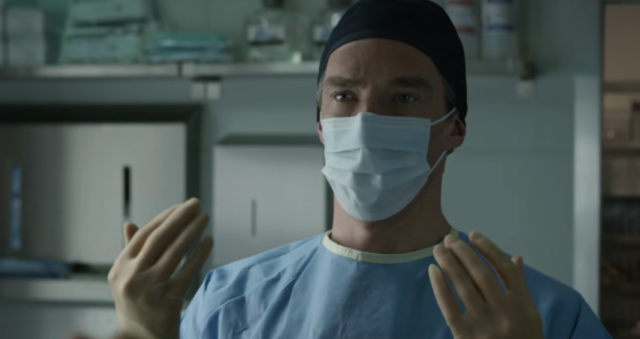When you get right down to it, neurosurgeons are, well, assholes. Sure, what they do is of value, but why they do it is, more than any other medical specialty, driven by selfdom (and the allure of a handsome salary). So naturally Marvel would build an anti-hero sort of comic book character around the seemingly indestructible ego of Doctor Stephen Strange back in 1963, when doctors were still viewed with reverent, god-like respect. Because what could be a more fatal flaw than ego–ergo a more interesting obstacle to watch the protagonist surmount?
Over Doctor Strange’s many incarnations througout the years (including the ghetto-ly adapted Doctor Mordid in 1992), his latest, interpreted by Benedict Cumberbatch, is perhaps his most powerful, profound and detailed. As we’re introduced to Doctor Strange’s unique brand of arrogance in the operating room, we find that it extends not only to his confidence in skill, but his assurance in knowledge of the minutiae. This includes song trivia as his assistant plays him Chuck Mangione’s “Feels So Good” and asks him the year it came out. When Dr. Strange responds “1977” without missing a beat, his assistant refutes him with 1978. But Dr. Strange, never one for being wrong, argues his point, saying that while, yes, the song charted in ’78, the album was released in December of ’77. It is nuances like these that contribute to the overall unlikeability of Strange, in spite of his brilliance as a surgeon. Even in terms of his grudging romance with colleague Christine Palmer (Rachel McAdams), Strange can barely muster up the crumbs of emotion necessary to return her overt affection. In point of fact, the only public place he’s willing to invite her to is a lecture he’s giving at some stodgy black tie event.
As one of the few people who cuts him down to size, Christine doesn’t take him up on the offer, leaving Strange to drive there himself. Speeding in his slick sports car, Strange ends up crashing his car, causing severe nerve damage to his most valuable assets: his hands. When he wakes up in the hospital with Christine at his side, he’s horrified to see his hands looking like some sort of mangled experiment.
Crazed with the desire to repair the damage, Strange spends all his money on treatments that won’t succeed. When Christine suggests his life can have meaning beyond work, he snaps back at her, “Like what? You?” It is this that prompts Christine to leave him alone, destined to follow a different path recommended to him by another former seemingly non-recovery bound patient of the hospital, Jonathan Pangborn (Benjamin Bratt–remember him?). When Pangborn tells Strange of how he was healed at Kamar-Taj, a hidden compound in Kathmandu run by a woman referred to only as The Ancient One (Tilda Swinton), Strange jumps on the next available flight.
Led to Kamar-Taj by one of its leading students, Karl Mordo (Chiwetel Ejiofor), The Ancient One has no trouble informing Strange that his hubris will only hold him back if he continues to let it rule his life. Vexed by what he deems her peddling of gift shop philosophy based on chakras and other mumbo jumbo, The Ancient One humbles him by showing him what is referred to as the multiverse: layers upon layers of alternate dimensions that the average human can neither see nor fathom.
Though at first his journey to Nepal is about mending his hands to re-pursue his old glory as a neurosurgeon, it soon becomes about something else. As an epic battle brews between the compound and one of its defected students, Kaecilius (Mads Mikkelsen), it becomes increasingly clear to The Ancient One, Mordo and Strange that his allegiance with the Dark Dimension’s reigning authority, Dormammu, will only result in a war of the multiverses.
Meanwhile, Mordo’s respect for The Ancient One and all she did for him to help him quell his demons results in her ominous negation, “We don’t get rid of our demons. We can only learn to live above them.” This cryptic statement establishes a larger secret The Ancient One has been harboring, one that only Kaecilius has thus far been made aware of.
With the hubs of energy protected by the Sanctums in New York, London and Hong Kong, the fate of many rests squarely on Strange’s extremely pretentious shoulders. It is his braggadocio that leads Strange down a path of sorcery that could tear at the very fabric of the space-time continuum–which, yes, he resorts to doing in order to combat Dormammu (in a hilarious Sisyphean time loop). Upset by how overtly Strange has upset the natural order, Mordo insists, “The bill comes due–always.” This, of course, sets up some fucked up shit to happen for the inevitable sequel.
Considering how long it has taken for the tale of Doctor Strange to be told in a big budget way, it’s evident that writer-director Scott Derrickson was meticulous in developing this long drawn-out project, which has passed through the hands of many rights owners and potential talent since 1986. To be sure, one would like to imagine what Alex Cox’s (best known for Repo Man and Sid and Nancy)–at one point a co-writer for the script in 1989–imagining of Doctor Strange would have been. Still, no matter who ended up directing the film, no Marvel vehicle be complete without a cameo by Stan Lee, this time reading Aldous Huxley’s The Doors of Perception.





















